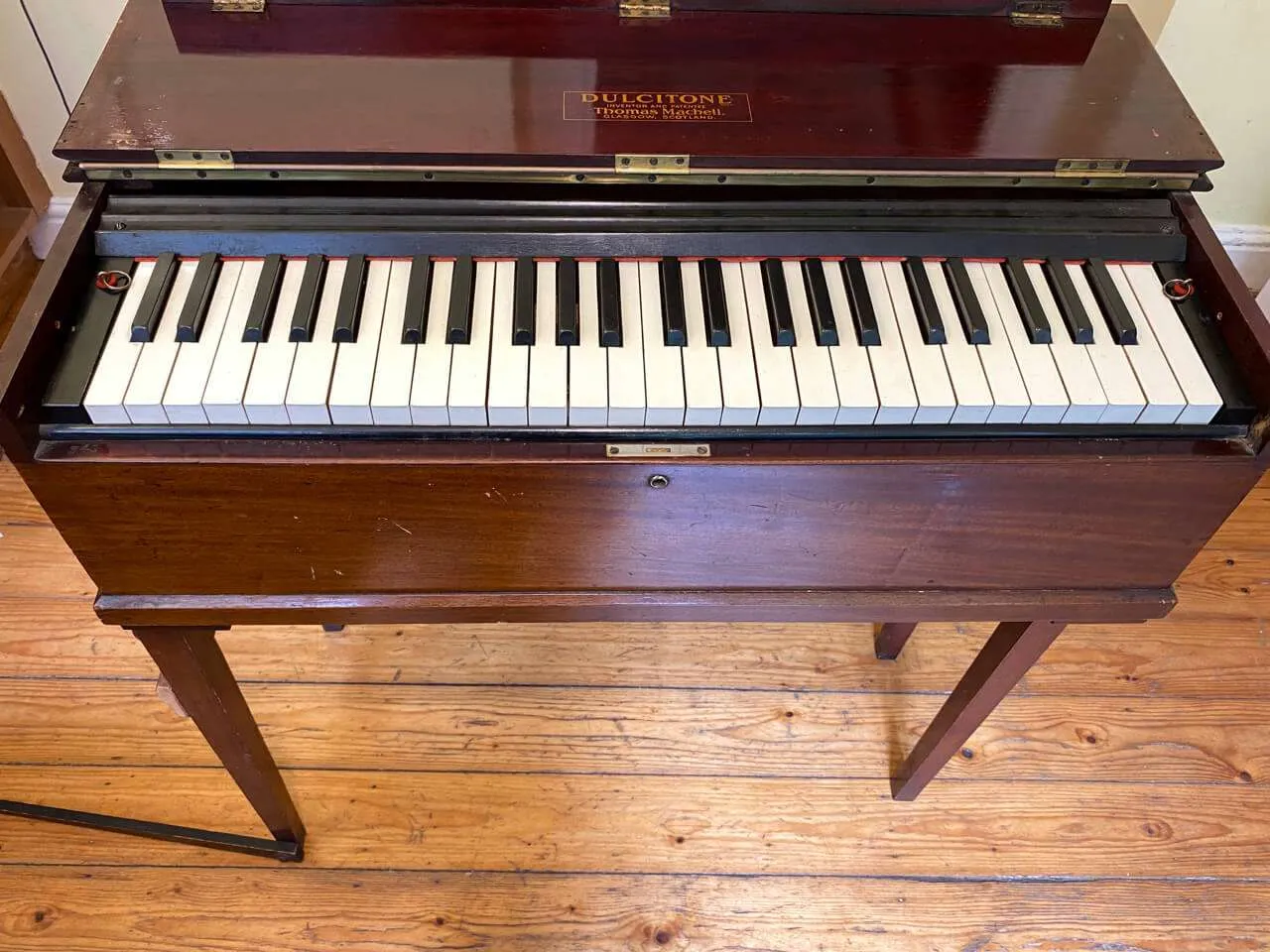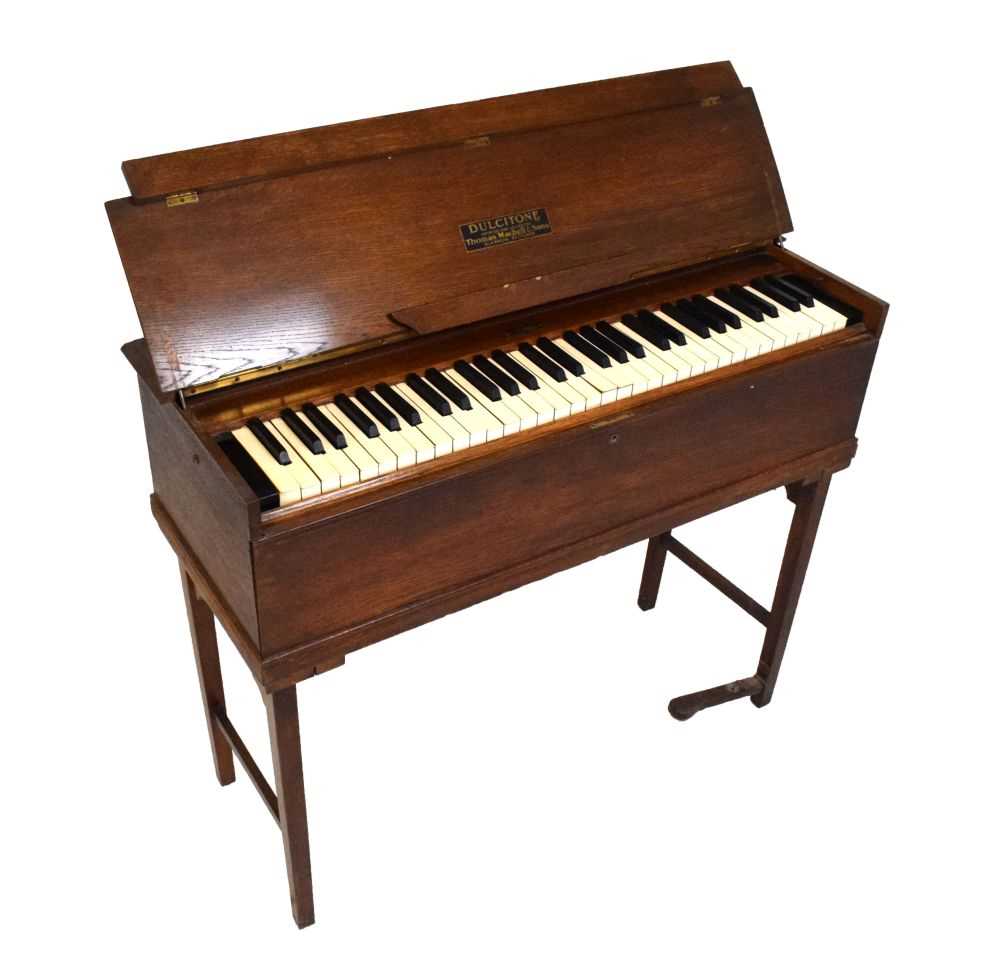Dulcitone
Keyboard Instruments
Europe
Between 1001 and 1900 AD
Video
The dulcitone is a unique, keyboard-based percussion instrument that produces sound through a series of tuned, free-standing steel tuning forks rather than strings. It is often classified as an idiophone, as its sound is generated through the vibration of metal rather than strings, air columns, or membranes. This instrument has a distinct, bell-like timbre, which gives it an ethereal and delicate tonal quality.
Physically, the dulcitone resembles a small upright piano, with a wooden case that houses the tuning forks and the associated hammer action. Unlike conventional pianos or harpsichords, the dulcitone does not use strings to create sound. Instead, felt-covered hammers strike the metal tuning forks, producing vibrations that resonate through the wooden soundboard. This results in a warm, mellow sound that is both soft and clear, making it particularly suited for intimate musical settings.
Types and Features
Dulcitones come in various sizes and designs, though their fundamental principles remain the same. Some models have a more elaborate construction, with improved hammer mechanisms for a more precise attack. The primary features of a dulcitone include:
Keyboard Layout: Similar to a piano, featuring white and black keys for chromatic playability.
Tuning Fork Mechanism: Instead of strings, each note is produced by a tuning fork tuned to a specific pitch.
Hammer Action: Small felt hammers, connected to the keyboard, strike the tuning forks when a key is pressed.
Portable Wooden Frame: The instrument was designed for portability, making it smaller and lighter than pianos or harpsichords.
Limited Dynamic Range: Unlike a piano, the dulcitone does not have a sustain pedal and has limited volume variation due to the nature of its sound production.
Some dulcitones were designed with additional mechanisms to enhance tonal control, but most followed a standard format suited for salon music and small ensemble performances.
History and Origin
The dulcitone has a fascinating history that traces back to the 19th century. It was invented in Scotland during a period when keyboard instrument innovation was at its peak. This era saw the creation of numerous experimental keyboard designs, many of which sought to refine or replace the piano’s heavy, cumbersome mechanism with something more portable and mechanically simple.
The dulcitone originated in Europe, specifically Scotland, in the 19th century. The instrument was first developed by Thomas Machell of Glasgow, who patented it in the late 1860s. This period was marked by significant advances in instrument craftsmanship, particularly in keyboard instruments. The 19th century saw an increasing demand for portable instruments that could be used in homes and small concert settings, leading to the creation of innovative alternatives to the piano and harmonium.
The dulcitone was developed as a response to this demand. It was designed to be a lightweight alternative to the piano, with a softer, more controlled sound that made it ideal for parlors and small chamber performances. Machell’s design sought to reduce the complexity and bulk of traditional pianos while maintaining a pleasing tone that could complement both solo and ensemble music.
Work Mechanics
The dulcitone operates using a simple yet effective mechanical system. When a key is pressed, a small hammer covered in felt strikes a metal tuning fork. The tuning fork vibrates at a precise frequency, producing a clear, bell-like sound. Unlike pianos, which rely on strings that require frequent tuning, tuning forks are more stable and do not detune as easily. This made the dulcitone a low-maintenance instrument, a feature that was highly appealing in its time.
One key characteristic of the dulcitone’s mechanics is its lack of sustain. Unlike a piano, where the sustain pedal can allow notes to ring out longer, the dulcitone’s tuning forks produce a naturally decaying sound that cannot be artificially prolonged. This results in a more staccato, percussive playing style, making the instrument suitable for specific musical applications but limiting its expressiveness in certain settings.
Role in Music
The dulcitone played a significant role in the evolution of keyboard instruments, particularly in the context of salon music and chamber ensembles. Due to its soft and resonant tone, it was often used for light classical compositions and accompaniment in smaller gatherings.
The instrument’s gentle, bell-like quality made it a popular choice for music that required a delicate touch. Composers occasionally incorporated the dulcitone into their works for its unique timbre, although it never achieved widespread popularity as a concert instrument. Despite this, the dulcitone remains a cherished instrument among enthusiasts of historical and obscure keyboard instruments.
In addition to classical music, the dulcitone was sometimes used in folk music arrangements, particularly in Scotland and other parts of Europe where it was initially produced. It also found occasional use in church music, providing a soft and reverent alternative to organs and harmoniums in smaller chapels.
Significance of the Dulcitone
Despite its niche status, the dulcitone holds an important place in the history of musical instrument development. It represents an era of experimentation and innovation in keyboard instrument design, demonstrating the potential of alternative sound production methods beyond traditional strings or reeds.
One of the key aspects of the dulcitone’s significance is its portability. Unlike pianos, which were heavy and required careful tuning and maintenance, the dulcitone was designed to be relatively lightweight and stable in pitch. This made it particularly appealing to traveling musicians and those who needed an easily transportable keyboard instrument. Additionally, the dulcitone’s distinct sound makes it valuable in modern music production. In recent years, there has been a resurgence of interest in vintage and obscure instruments, with musicians and composers incorporating their unique tones into contemporary compositions. The dulcitone’s ethereal and chime-like quality makes it well-suited for ambient music, film scores, and experimental soundscapes.
Another factor contributing to the dulcitone’s significance is its influence on later instruments. While it did not replace the piano, its design principles have informed other keyboard instruments, particularly those exploring alternative sound production methods such as electric pianos and digital synthesizers. The concept of using tuning forks as a primary sound source was later employed in instruments like the Rhodes electric piano, which became immensely popular in jazz, rock, and pop music.
It remains a fascinating and historically important instrument. While it may not have reached the prominence of the piano or organ, its unique sound and mechanical ingenuity ensure its continued appreciation among musicians, collectors, and instrument historians. Today, preserved dulcitones can be found in museums, private collections, and some recording studios, where their distinctive voice continues to inspire new generations of musicians.
FAQ
What type of instrument is the dulcitone?
The dulcitone is classified as an idiophone, a type of instrument that produces sound through the vibration of the instrument itself, similar to a celesta or a vibraphone. It is a keyboard instrument that uses tuning forks struck by felt-covered hammers to produce sound.
What are some notable features of the dulcitone?
Notable features of the dulcitone include its portability, resistance to tuning issues, and soft, ethereal sound. It is typically constructed with a wooden frame and features a simple mechanism for lifting dampers. The instrument is well-suited for intimate performances or chamber music.
What materials are commonly used in the construction of the dulcitone?
The dulcitone is commonly constructed with a wooden frame, often made of mahogany or oak. The keys are typically made of ivory and ebony, while the sound-producing elements are metal tuning forks struck by felt-covered hammers.
 Links
Links
References
Other Instrument
Categories



















